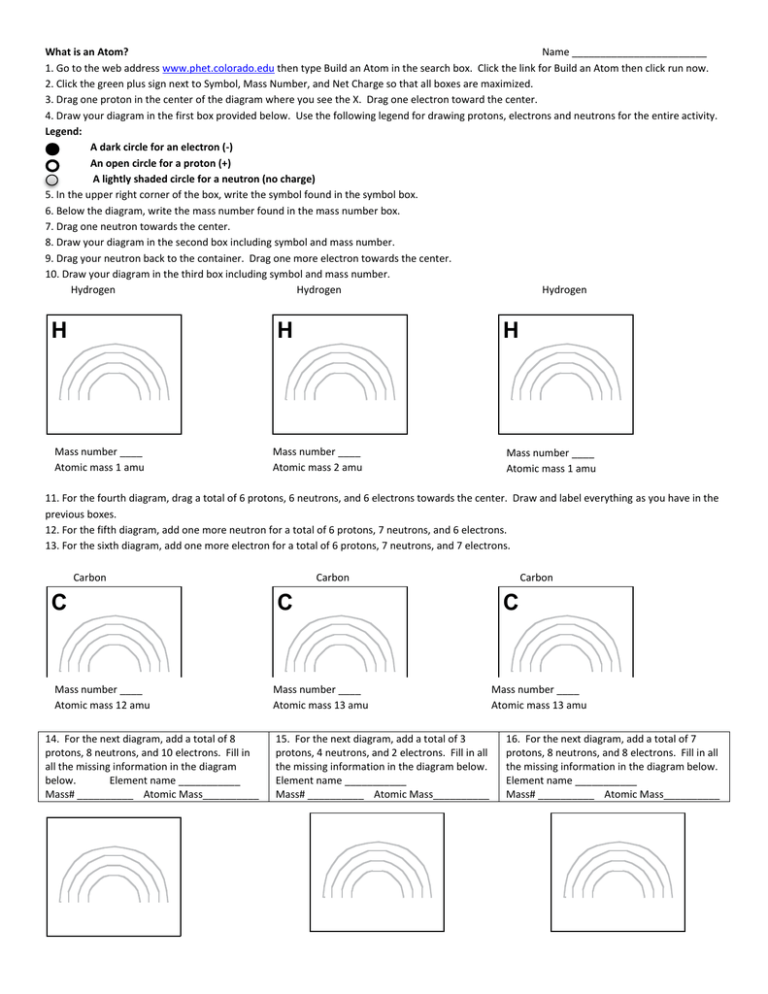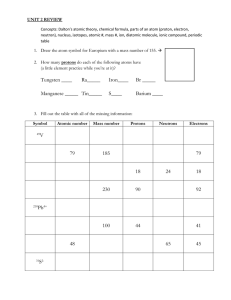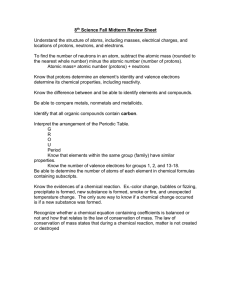What is an Atom? Name 1. Go to the web address www.phet
advertisement

What is an Atom? Name ________________________ 1. Go to the web address www.phet.colorado.edu then type Build an Atom in the search box. Click the link for Build an Atom then click run now. 2. Click the green plus sign next to Symbol, Mass Number, and Net Charge so that all boxes are maximized. 3. Drag one proton in the center of the diagram where you see the X. Drag one electron toward the center. 4. Draw your diagram in the first box provided below. Use the following legend for drawing protons, electrons and neutrons for the entire activity. Legend: A dark circle for an electron (-) An open circle for a proton (+) A lightly shaded circle for a neutron (no charge) 5. In the upper right corner of the box, write the symbol found in the symbol box. 6. Below the diagram, write the mass number found in the mass number box. 7. Drag one neutron towards the center. 8. Draw your diagram in the second box including symbol and mass number. 9. Drag your neutron back to the container. Drag one more electron towards the center. 10. Draw your diagram in the third box including symbol and mass number. Hydrogen Hydrogen Hydrogen H H Mass number ____ Atomic mass 1 amu H Mass number ____ Atomic mass 2 amu Mass number ____ Atomic mass 1 amu 11. For the fourth diagram, drag a total of 6 protons, 6 neutrons, and 6 electrons towards the center. Draw and label everything as you have in the previous boxes. 12. For the fifth diagram, add one more neutron for a total of 6 protons, 7 neutrons, and 6 electrons. 13. For the sixth diagram, add one more electron for a total of 6 protons, 7 neutrons, and 7 electrons. Carbon C Mass number ____ Atomic mass 12 amu 14. For the next diagram, add a total of 8 protons, 8 neutrons, and 10 electrons. Fill in all the missing information in the diagram below. Element name ___________ Mass# __________ Atomic Mass__________ Carbon C Mass number ____ Atomic mass 13 amu 15. For the next diagram, add a total of 3 protons, 4 neutrons, and 2 electrons. Fill in all the missing information in the diagram below. Element name ___________ Mass# __________ Atomic Mass__________ Carbon C Mass number ____ Atomic mass 13 amu 16. For the next diagram, add a total of 7 protons, 8 neutrons, and 8 electrons. Fill in all the missing information in the diagram below. Element name ___________ Mass# __________ Atomic Mass__________ 1H and 2H are isotopes of hydrogen. 12C and 13C are isotopes of carbon. Critical Thinking Questions 1. In the table below list many protons, neutrons, and electrons are found in 12C? 13C? 13C-? 12C Sub-Atomic Particle 13C 13C – Protons Neutrons Electrons 4. Based on your answers to questions 1-3, what do all carbon atoms (and ions) have in common? 5. Based on your diagrams, what do all hydrogen atoms (and ions) have in common? 6. Based on your answers to questions 4 and 5, what is the significance of the atomic number above each atomic symbol in the periodic table? 7. Based on your answer to question 6, what do all nickel (Ni) atoms have in common? 8. In terms of the numbers of protons, neutrons, and electrons: a) Why does the notation 13C- have a negative sign in the upper right hand corner? b) What feature distinguishes a neutral atom from an ion? c) Provide an expression for calculating the charge on an ion. 9. Determine the number of protons, neutrons, and electrons in one 1H+ ion. Explain how you found your answer. 10. What structural feature is different in isotopes of a particular element? 11. How is the mass number, A, (left-hand superscript next to the atomic symbol as shown in your diagrams) determined (from the structure of the atom)? 12. How do you know if the mass number and charge given for 16O2- and 7Li+ are correct (from problems 14 and 15 on page 1)? 13. Based on your diagrams, where is most of the mass of an atom, within the nucleus or outside of the nucleus? Explain your reasoning using grammatically-correct sentences. Exercises 1. Complete the following table. ISOTOPE 31P 18O 58Ni2+ ATOMIC NUMBER Z 15 MASS NUMBER A 19 39 58 NUMBER OF ELECTRONS 8 18 2. Define mass number. 3. Define atomic number. 4. True / False - An 18O atom contains the same number of protons, neutrons, and electrons. 5. How many electrons, protons, and neutrons are found in each of the following? 24Mg 23Na+ 35Cl 35Cl56Fe3+ 15N 16O26. Complete the following table. ISOTOPE ATOMIC NUMBER Z MASS NUMBER A NUMBER OF ELECTRONS 27 59 25 14N 3 7 3 3 6 3 58Zn2+ 19F7. Using grammatically correct sentences, describe what the isotopes of an element have in common and how are they different. 27Al3+




